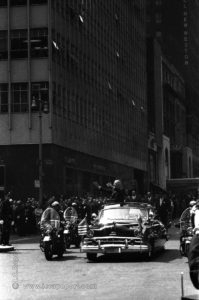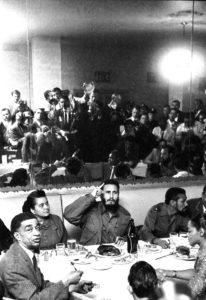GATHERING AT THE U.N.
(September 1960)
I was among hundreds of photographers, TV crews and print journalists, covering the historic event at the United Nations in the fall of 1960. It seemed every head of state had converged on New York to attend the meeting of the General Assembly. Chairman Nikita Khrushchev from the Soviet Union came to New York and his appearance prompted other heads of state like British Prime Minister MacMillan, Prime Minister Nehru from India, President Charles de Gaulle from France and various other heads of states, and Kings, Pashas, Imans and Emirs. The town was crawling with royalty, both by blood and politics. Hardly a midtown hotel was absent a lobby full of watchful security men, or a lineup of big black limos flying gold-fringed national flags from their shiny fenders. It was an exciting time to be a reporter or a photojournalist.

Because of the importance of this story and the expected 10 to 20 pages that needed to be filled, Paris Match had flown several photographers to N.Y. from Paris to add to Paul Slade’s group of freelancers; a group of which I was beginning to become a solid member. From Paris, Walter Carone, Jackie Garofalo and Dominque Berretty, and two of Match’s notable and local “crash” photographers, joined me: Vytas Valaitis, and Henri Daumain.
One of my assigned stories was to cover Nikita Khrushchev. This bizarre gathering was made famous the world over by Nikita removing his shoe and banging it on his desk in the General Assembly meeting. Paul Slade, who was directing the coverage, was sending Carone, Barretty, Garofalo, Valaitis, Daumain and myself, off to various locations to make sure everyone was covered. I was lucky to draw Fidel Castro, but before that, I was sent only one block away from the Match office, to Park Avenue and 67th Street to get a photograph, if possible, of Khrushchev. There weren’t many opportunities all photographers and newsreel cameramen were to discover. The best we could hope for was a position on several of the balconies in the apartment buildings surrounding the area. I found one and shared it with a photographer from London Daily Express. I looked up across the way and saw one of LIFE’s most notable photojournalists, Alfred Eisenstaedt, camped on a small balcony along with several photographers, the names of which I have long forgotten.


The highlight of my work at the United Nations event, besides taking the shot of a waving Khrushchev in front of the Soviet U.N. Embassy on Park Avenue was taking another photograph of Fidel Castro a year and a half after my first encounter with him. The last time Fidel had visited New York he was on an unofficial visit, and, having deposed a corrupt and brutal dictator who stole off the backs of the Cuban poor, was considered by most Americans to be a hero. On this visit, however, his fortunes with the American public had soured considerably. He was considered a pariah. By nationalizing most U.S. assets in Cuba for “the good of the Cubans” he managed to anger men in the highest places of U.S. government, officials who, in other lives, had owned the sugar and fruit companies Castro appropriated. Their anger, transmitted to the American people through the press, created an atmosphere ranging from disappointment to distrust and outright dislike for Fidel and his mostly bearded, olive-drabbed, uniformed cadre.
The last time he had been in New York City had been whisked from the New Yorker Hotel around the City and cheered by thousands in Central Park. This time, rather than staying in a swank midtown hotel suite, Fidel chose to be “with the people” and booked rooms for himself and his entire entourage at the Hotel Theresa on 124th Street, the center of Harlem.

One of the photographers who came to New York from Paris was Dominique Berretty, a mature and dashing shooter, who had covered a number of important assignments around the world. At Orly Field, the Paris Airport, on his way to New York, Berretty had run into a lovely 19-year-old American woman he had met the night before at a parisien restaurant. As they were both heading for N.Y., they shared a café and then, this young woman walked Berretty to his gate (he was flying on a different carrier) where she said goodbye to him wondering if perhaps she’d see him again in N.Y. (she didn’t).
When Berretty arrived at Idlewild Airport (now called JFK) I was there to gather him in and deliver him to the Match offices in Manhattan. I mention this only because I would meet that same young woman – Mary Feder – four months later in San Juan, Puerto Rico. We would begin an intense love affair and would marry 11 months later and stay married for 54 years. If you believe in the stars aligning, then only Dominique Berretty’s silver aircraft and three thousand miles separated Mary and me that first time.
